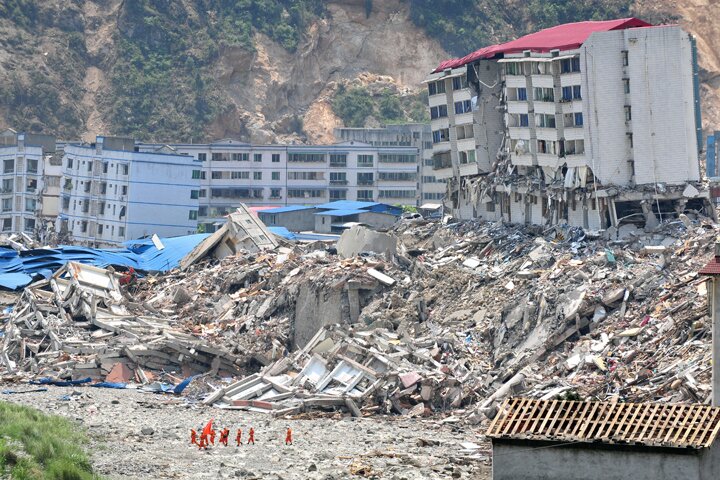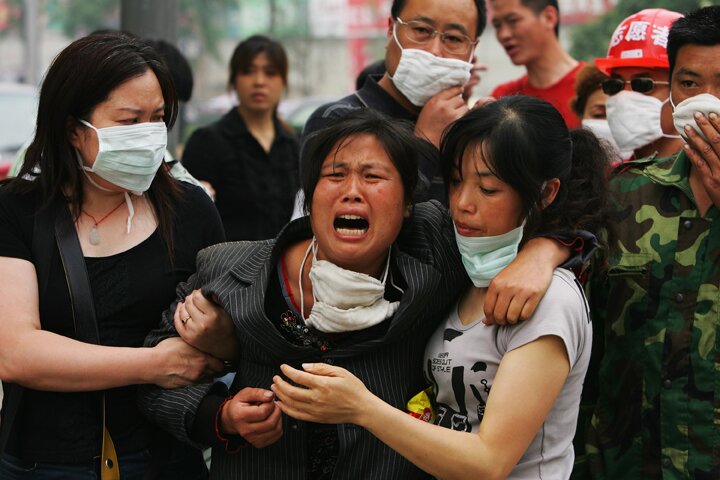
Myanmar, China—and Hope!
The wreckage is unfathomable. It’s as if nature went into giant, uncontrollable, ruinous epileptic fits. The results are physically sickening, enough to destabilize a person mentally, emotionally.
In central Myanmar, the destruction is similar to that of an area whose river has burst its banks, flattening flora and destroying all adjacent life. The difference: Cyclone Nargis didn’t merely overflow the Irrawaddy River—its 120-mile-per-hour winds pushed a 12-foot freight train of water 25 miles inland, swamping the river’s delta plain, smashing villages, ruining crops and food, contaminating fresh water supplies, and sweeping tens of thousands of people—most of whom were sleeping—to their deaths.
It’s a catastrophe of biblical proportions.
Eighteen days later, and despite the efforts of the military junta to prevent footage of the devastation (and of its own criminal negligence) from getting out, the world remains aghast at the images emanating from Myanmar. “A half-clothed baby’s body entangled in brush. Rows of lifeless children lying on the muddy ground, the face of one of them blue. Survivors crouching close together in mud under tarps” (abc News, May 14). Carnage of this magnitude cannot be contained.
The tear-drained eyes of survivors are as barren of hope as the wreckage encompassing them.
About 1,500 miles north, a similar portrait of death turns the stomachs of those brave enough to meditate on it. Eleven days ago, a magnitude 7.9 earthquake rocked the densely populated Sichuan province in central China. The quake—its epicenter 12 miles deep within Earth’s bowels—was so powerful that tremors were felt as far away as Thailand, Taiwan and India. While buildings in these regions groaned and swayed, thousands of buildings across Sichuan—many bustling with life—crashed to the ground, some capitulating to the furious shiver, others being smashed by house-sized boulders that rolled like marbles down the surrounding mountains.

Within minutes the picturesque Sichuan mountains, waterfalls and forests transformed into an unbearable continuum of blood-stained rubble cloaked in thick layers of dust and peppered with human remains. The province’s deep valleys, home to mountainside towns and resorts, became mass graves as the mountains—shaken by their tectonic lords—creaked and groaned, shedding millions of tons of dirt and debris onto civilization below.
Sichuan is now a graveyard.
“I was shaking with fear,” exclaimed Maureen Baker, a British tourist who was visiting a panda reserve in Wolong at the time of the quake. “I heard a loud bang and suddenly everything was shaking—the ground, trees and buildings. It was like being in the middle of an explosion. I remember thinking, if it wasn’t the end of the world, it must be an earthquake. Because we were in a gorge, the noise was amplified. There was a roar from either side. The mountains just seemed to explode as if they’d been detonated with dynamite.”
Since the original quake, multiple aftershocks, in addition to heavy rainfall and flooding, have triggered mudslides, hampered relief efforts and terrified survivors already paralyzed with shock. Like Myanmar, the picture of carnage is hard to fathom: The death toll lies at 40,000, with at least 10,000 more assumed dead, tens of thousands more injured and more than 5 million homeless, their bellies aching with hunger and in desperate need of shelter.
Tens of millions of people in Asia will likely be affected by nature’s furious assault on Myanmar and China. Critical crops in Myanmar have been destroyed, reducing food supplies and pushing Asia’s already-tight rice supplies to their limits. “Our biggest fear is that the aftermath could be more lethal than the storm itself,” said Caryl Stern, who heads the United Nations Children’s Fund in the United States. Food prices across Myanmar have rocketed; electricity is non-existent in many areas; critical infrastructure—roads, buildings, drainage systems—are in shambles. The potential for massive outbreaks of water-borne diseases looms. China faces similar blights.
Then there’s the psychological impact. “It was very heart-wrenching to see the children there,” recalled Clark Wang, a volunteer sifting through rubble in Sichuan. “Many had lost their entire families. They were so young and innocent. They were dressed in very dirty clothes and none of them smiled or laughed. It was a very somber environment. Many of them were crying and the girls tried to comfort them. But what could they say that would help?”
Good question.

Think about that: How would you explain these crises to a newly orphaned child? To a limbless survivor? To a father who has just lost his entire family? To a family that just lost its patriarch? By now the plume of hopelessness over Myanmar has combined with the mushroom cloud of anguish over China and is drifting across the planet. Tens of millions have been impacted—many psychologically and emotionally, some spiritually.
Maybe you have been. I have.
It’s hard not to be. Many are confused and baffled; others are disheartened and dejected, not just by the carnage, but because they have no explanation for why it happened. Others are purple with rage, livid at the lack of answers from their religion and at their god (whomever that might be) for allowing such tragedies. Hopelessness prevails.
Intense anguish sometimes produces a beneficial by-product: humility. You know many of the survivors of Cyclone Nargis and the Sichuan earthquake are humble and submissive right now. Their livelihood is in the hands of others, totally. And humility is the foundation of all proper understanding (Proverbs 1:7; Isaiah 66:2). There is understanding and hope to be found in the catastrophes unfolding in Myanmar and China! The key to unlocking that understanding is possessing humility and a submissive, open mindset.

The reality is, God’s Word does explain—in explicit detail—why such catastrophes happen. The causes are spelled out from the first book of the Bible to the last. And those people with humble and open minds can understand those causes. This column is not about why these disasters occurred. You can learn that answer in “Where Was God?” I want to talk about another hope-filled reality buried amid the rubble in Myanmar and China.
Both these events, forecasted nearly 2,000 years ago, are a sign that the Son of God is about to return to this Earth.
Perhaps that strikes you as preposterous—an easy way to spiritualize away the physical pain and mental and emotional anguish. But what if it is true? What if, upon further investigation, you can personally prove, beyond doubt, that these tragedies do in fact tell us that Christ’s return is imminent?
You couldn’t have a more hope-filled, joyous experience than that!
In Matthew 24, Jesus’s disciples asked what signs would precede His Second Coming and the end of this present world. He responded by delivering the most pivotal prophecy of His earthly ministry, the Olivet prophecy. Every end-time Bible prophecy revolves around it. It’s important you prove this for yourself; so dig out your Bible and read Christ’s own words with your own eyes.
Christ was speaking about the time we are living in right now. In verses 21-22, He said that He would return at a time when all human flesh would risk being destroyed. This can only be talking about today’s nuclear age. These are obviously end-time prophecies.
Now notice verses 4-5: “And Jesus answered and said unto them, Take heed that no man deceive you. For many shall come in my name, saying, I [Christ] am Christ; and shall deceive many.” Christ’s first warning was that people—false teachers and ministers—would come in His name, talking about Christ, but not teaching Christ’s message. These false ministers, he said, would deceive many!
The prophecy continues: “And ye shall hear of wars and rumors of wars: see that ye be not troubled: for all these things must come to pass, but the end is not yet. For nation shall rise against nation, and kingdom against kingdom: and there shall be famines, and pestilences, and earthquakes, in divers [different] places” (verses 6-7).
Jesus told His disciples that terrible natural disasters would precede His Second Coming. He warned specifically that there would be earthquakes in different places. China’s recent devastation was caused by a 7.9 earthquake, which jolted mountains and leveled thousands of buildings. Even now, regular aftershocks terrorize people. Christ said this would happen: devastating earthquakes in different places. We are seeing an increase in frequency of earthquakes all over the world—and, if we believe Christ, we should expect more of them.
He also warned of famines—a shortage of food and water—and then pestilences, or disease epidemics. Myanmar is strewn with ruined crops and rotting, disease-breeding corpses. Authorities fear the aftermath will be worse than the initial devastation caused by the cyclone. Earthquakes, famines, pestilence: These are among the signs Christ gave of the end of the world, and the lead-up to His return!
Natural disasters are a barometer of the time left before Jesus’s return: The more natural disasters, the sooner Christ’s coming is!
The wreckage in Asia is unfathomable. But buried between the piles of rubble and hopelessness is a spectacular hope, just waiting to be discovered. These disasters are a sign that this present evil world is about to end altogether, and that Jesus Christ is about to return! Why won’t more people believe Christ’s words, especially when they witness calamities such as what happened in Myanmar and China, and latch onto this invigorating hope? The human mind is illogical. Many people, particulary the scholarly, will scorn this knowledge from Christ. Yet they themselves have absolutely no answers for what happened in Myanmar and China; they remain utterly devoid of hope. Mankind prefers to live in hopelessness rather than listen to instruction from their Creator.
Christ’s prophecy in Matthew 24 then gets even more profound. Jesus knew human nature so well, He understood that despite these terrible disasters, most people would still refuse to acknowledge His presence and heed His instruction. That’s why in verse 8, He tells His disciples that all these natural disasters—the earthquakes, famines, pestilences—“are the beginning of sorrows.”
The proclivity of human nature to reject heavenly signs and spiritual instruction is frightening!
What we have witnessed in China and Myanmar, and in an increasing number of places elsewhere in the world, is merely the beginning of an unimaginable series of sorrows to befall mankind. Why does the calamity intensify? Because few who observe tragedies like Myanmar and the China quake allow the carnage to spur them toward deep contemplation and sincere self-analysis; few will allow these crises to prick their hearts and spark a search for real answers.
Nothing is more hypocritical than the human heart. Millions of people profess to love Jesus and believe what He taught. But few believe what He actually said. Few believe in the future news events He prophesied—and now world events are exposing that terrible hypocrisy.
You need to make it a goal to learn Christ’s prophecies, and then watch and pray as they unfold. If you do this, prepare to be stunned by how accurate they are. Every one of them is on course to be fulfilled.
Myanmar and China are currently enduring “living hell.” But there is hope in the gut-wrenching carnage: Those events fulfill Bible prophecy, not only proving the Bible’s veracity, but proving also the imminency of Jesus Christ’s return, and infusing those who have humble, submissive minds with profound, transcendent hope!
